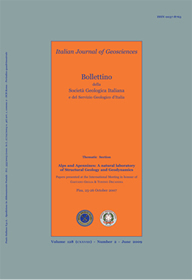
Structural inheritance of pre- and syn-orogenic normal faults on the arcuate geometry of Pliocene-Quaternary thrusts: Examples from the Central and Southern Apennine Chain
Fernando Calamita(*), Paolo Esestime(*), Werter Paltrinieri(*), Vittorio Scisciani(*) & Enrico Tavarnelli(**)
(*) Dipartimento di Scienze della Terra, Università «G. d'Annunzio» di Chieti e Pescara, Via dei Vestini, 30 - 66013 Chieti Scalo, Italy.
(**) Dipartimento di Scienze della Terra, Università di Siena, Via Laterina, 5 - 56100 Siena, Italy. Calamita Fernando: Tel. 0871/3556411; Fax 0871/3556454; calamita@unich.it.
DOI: https://doi.org/10.3301/IJG.2009.128.2.381
Volume: 128 (2009) f.2
Pages: 381-394
Abstract
n the frontal sector of the Central-Southern Apennines, surface geological data integrated with seismic line interpretation provide new constraints into the reconstruction of the structural inheritance of Mesozoic pre-orogenic and Messinian-Pliocene syn-orogenic normal faults on the salient geometry of the Pliocene-Quaternary thrust system.
In the Umbria-Marche-Abruzzi area, pre-orogenic normal faults commonly juxtapose the complete Jurassic succession (about 900 metres in thickness) onto coeval condensed successions (about 50 metres in thickness) deposited over structural highs. In the Sibillini Mts and Gran Sasso area, pre-orogenic normal faults are truncated and rotated into Pliocene thrust-sheets according to simple short-cut trajectories. In particular the foreland-dipping Jurassic normal faults in the Sibillini Mts area have been rotated and reactivated during the thrust propagation forming high-angle blind-thrusts in the east verging overturned folds.
The Maiella anticline, which involves the Mesozoic-Miocene Apulian carbonate succession and the related slope deposits, joins the Central Apennine fold-and-thrust system to the Apulian Chain buried below the allochthonous Units of the Southern Apennines. Seismic line interpretation allowed us to reconstruct the three-dimensional pattern of the Apulian thrusts, oriented N-S, NNW-SSE and E-W, that are parallel to normal faults related to the Pliocene-Quaternary flexural extension in the foreland. Detailed reconstruction of the Setteporte and Monte Taburno structures shows main N-S/NNE-SSW trending thrusts, branching into NW-SE/E-W trending minor thrusts and back-thrusts, characterized by push-up geometry, typically referable to a transpressive deformation and/or to the positive reactivation of normal faults. Moreover, the sharp westward deepening of the base of the Apulian sedimentary succession (from 4.5 to 6.0 sec in TWT), based on the interpretation of the CROP 11 seismic reflection profile, and the concomitant increase in thickness of the Triassic sequence along the Maiella-Casoli transect, suggest the existence of west-dipping (?)Permian-Triassic normal faults that strongly controlled the distribution and thickness variation of syn-rifting sediments. An inversion of the deepest low angle portions of the pre- and syn-orogenic normal faults is in agreement with surface data (i.e., the structural elevation of the carbonate succession in the Casoli-Bomba anticline) and seismic line interpretation (i.e., deep seated location of the base of Apulian sedimentary succession below the same anticline).
In the reconstructed inversion tectonics model, the N-S trending pre-thrusting normal faults are fully inverted as N-S transpressive segments of the salient structures of the chain, whereas, the NW-SE trending thrusts inverted the low angle portion of pre-thrusting normal faults in the middle-lower crust and displaced with a short-cut the normal faults in the upper portion of the crust. As a result, the pattern of the pre-existing normal faults is inherited on the salient structures of the Central and Southern Apennine Chain.
Keywords
Get Full Text